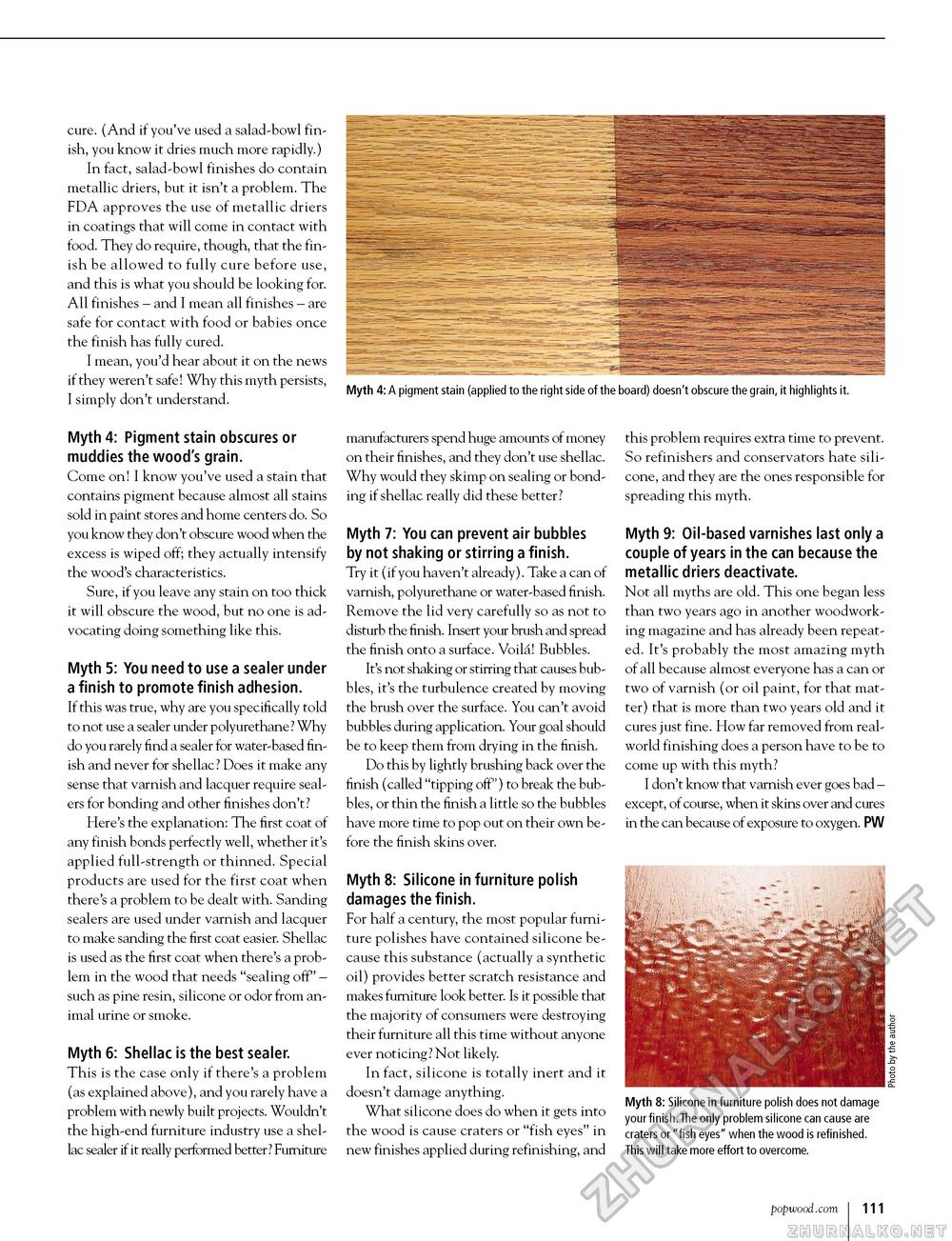Popular Woodworking 2003-12 № 138, страница 110
cure. (And if you've used a salad-bowl finish, you know it dries much more rapidly.) In fact, salad-bowl finishes do contain metallic driers, but it isn't a problem. The FDA approves the use of metallic driers in coatings that will come in contact with food. They do require, though, that the finish be allowed to fully cure before use, and this is what you should be looking for. All finishes - and I mean all finishes - are safe for contact with food or babies once the finish has fully cured. I mean, you'd hear about it on the news if they weren't safe! Why this myth persists, I simply don't understand. Myth 4: Pigment stain obscures or muddies the wood's grain. Come on! I know you've used a stain that contains pigment because almost all stains sold in paint stores and home centers do. So you know they don't obscure wood when the excess is wiped off; they actually intensify the wood's characteristics. Sure, if you leave any stain on too thick it will obscure the wood, but no one is advocating doing something like this. Myth 5: You need to use a sealer under a finish to promote finish adhesion. If this was true, why are you specifically told to not use a sealer under polyurethane? Why do you rarely find a sealer for water-based finish and never for shellac? Does it make any sense that varnish and lacquer require sealers for bonding and other finishes don't? Here's the explanation: The first coat of any finish bonds perfectly well, whether it's applied full-strength or thinned. Special products are used for the first coat when there's a problem to be dealt with. Sanding sealers are used under varnish and lacquer to make sanding the first coat easier. Shellac is used as the first coat when there's a problem in the wood that needs "sealing off' -such as pine resin, silicone or odor from animal urine or smoke. Myth 6: Shellac is the best sealer. This is the case only if there's a problem (as explained above), and you rarely have a problem with newly built projects. Wouldn't the high-end furniture industry use a shellac sealer if it really performed better? Furniture Myth 4: A pigment stain (applied to the right side of the board) doesn't obscure the grain, it highlights it. manufacturers spend huge amounts of money on their finishes, and they don't use shellac. Why would they skimp on sealing or bonding if shellac really did these better? Myth 7: You can prevent air bubbles by not shaking or stirring a finish. Try it (if you haven't already). Take a can of varnish, polyurethane or water-based finish. Remove the lid very carefully so as not to disturb the finish. Insert your brush and spread the finish onto a surface. Voila! Bubbles. It's not shaking or stirring that causes bubbles, it's the turbulence created by moving the brush over the surface. You can't avoid bubbles during application. Your goal should be to keep them from drying in the finish. Do this by lightly brushing back over the finish (called "tipping off") to break the bubbles, or thin the finish a little so the bubbles have more time to pop out on their own before the finish skins over. this problem requires extra time to prevent. So refinishers and conservators hate sili-cone, and they are the ones responsible for spreading this myth. Myth 9: Oil-based varnishes last only a couple of years in the can because the metallic driers deactivate. Not all myths are old. This one began less than two years ago in another woodworking magazine and has already been repeated. It's probably the most amazing myth of all because almost everyone has a can or two of varnish (or oil paint, for that matter) that is more than two years old and it cures just fine. How far removed from real-world finishing does a person have to be to come up with this myth? I don't know that varnish ever goes bad -except, of course, when it skins over and cures in the can because of exposure to oxygen. PW Myth 8: Silicone in furniture polish damages the finish. For half a century, the most popular furniture polishes have contained silicone because this substance (actually a synthetic oil) provides better scratch resistance and makes furniture look better. Is it possible that the majority of consumers were destroying their furniture all this time without anyone ever noticing? Not likely. In fact, silicone is totally inert and it doesn't damage anything. What silicone does do when it gets into the wood is cause craters or "fish eyes" in new finishes applied during refinishing, and ^ * ■., as*!* ^ ^ V, * j** ■■■ ■ Myth 8: Silicone in furniture polish does not damage your finish. The only problem silicone can cause are craters or "fish eyes" when the wood is refinished. This will take more effort to overcome. popwood.com 109 |








